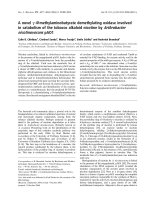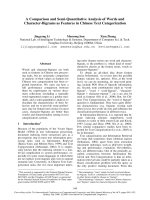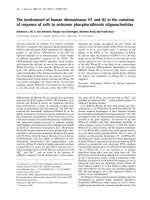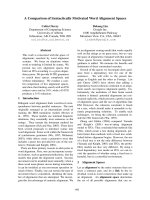Báo cáo khoa học: "A comparison of decision-making by physicians and administrators in healthcare settings" ppt
Bạn đang xem bản rút gọn của tài liệu. Xem và tải ngay bản đầy đủ của tài liệu tại đây (36.9 KB, 3 trang )
Page 1 of 3
(page number not for citation purposes)
Available online />Abstract
Physicians and administrators are committed to the same goal of
providing quality care at affordable costs. Their perceptions of
each other and their resulting behaviors, however, may lead to
conflict. We offer some insight into these perceptions and
behaviors, and provide a framework to improve communication and
to reduce misunderstanding.
Introduction
The chief of critical care walks into the Chief Executive
Officer’s office to discuss the proposal to purchase a new
electronic order entry system for medications. The Chief
Executive Officer is asking for justification to purchase this
unit. The chief does not feel any justification is needed
beyond ‘it is simply good for patient care’. The administrator
wants a business plan outlining the need for this system, its
fixed and variable costs, and its projected savings. The
meeting ends with both participants frustrated.
‘Physicians are naïve, they don’t realize that we cannot
provide what we cannot afford’, states the administrator.
‘Administrators don’t care about patients, they only care
about their bottom line’, states the physician. These are the
typical perceptions of each other.
While it may seem that physicians and healthcare
administrators are pursuing different goals, both are committed
to one goal: value for patients [1]. Value, however, is a product
of quality (good outcomes) and cost (efficiency). Conflict arises
because each group perceives that they are responsible for
meeting mutually exclusive objectives. For example, the critical
care physician may think they are responsible for ensuring
good patient outcomes only, while the administrator may think
they are responsible for system efficiency and costs only.
Cognizant of these disparate perceptions of each other, in the
present article we offer some insight into these behaviors and
offer some suggestions to bridge the chasm. We also outline
how the principles of organizational justice can improve
communication and reduce misunderstanding.
Behaviors and decision-making
In Systems of Survival, Jacobs [2] presents a framework that
divides the behavior paramount in all types of jobs into one of
two groups – ‘traders’ and ‘guardians’. According to Jacobs,
the moral behaviors characteristic of the trader (Table 1) are
typical of individuals in business and commerce, and are also
found in physicians and scientists. Unlike traders, guardians –
including healthcare administrators – typically ensure that
policies and procedures are followed and that there is a
perception of fairness in the system (Table 2).
Decision-making in healthcare settings is intimately tied to
these behaviors and relationships. A respect for hierarchy and
an acceptance of deceit for the sake of the task (Table 2) is the
anathema of ‘collaboration, competitiveness and dissent for the
sake of the task’ (Table 1). Systems that depend on both of
these behavioral types to operate successfully are clearly ripe
for conflict. This may be especially true in the Canadian
healthcare system, where the principles of equity and
universality reinforce Jacob’s roles and moral frameworks. The
irony is that not only are both moral constructs required in
hospital and academic institutions, but that each group also
wants the best for patients, equity in resource allocation (truer
among administrators), opportunities for innovation and creativity
(truer among physicians), and recognition and rewards for their
expertise and efficiency (both administrators and physicians).
These ‘moral behaviors’ support a model of relationships
between individuals that, at the simplest level, can be
described as either ‘superior-inferior’ (guardian) or
‘independent-equal’ (trader) relationships. Superior-inferior
relationships are common in administrative organizations –
such as is found in hospitals – where structural authority is
integral and there is a need to control and manage systems,
outputs and decisions. Independent-equal relationships are
common in environments – also found in hospitals –that
respect independent action, open discussion and innovation,
and where advice is sought and considered but external
direction may not be accepted readily.
Commentary
A comparison of decision-making by physicians and
administrators in healthcare settings
David S Matheson and Niranjan Kissoon
Department of Pediatrics, University of British Columbia, Children’s Hospital Rm K4-105, 4480 Oak Street, Vancouver, British Columbia, Canada V6H 3V4
Corresponding author: Niranjan Kissoon,
Published: 5 September 2006 Critical Care 2006, 10:163 (doi:10.1186/cc5028)
This article is online at />© 2006 BioMed Central Ltd
Page 2 of 3
(page number not for citation purposes)
Critical Care Vol 10 No 5 Matheson and Kissoon
Influence of behavior on relationships
Physicians are taught (through educational ward rounds) that
dissent is approved of, will not be taken as a personal
criticism and will even be rewarded. This reinforces the
independent-equal construct for physicians. Dissent by a
physician in an administrative setting, however, is frequently
taken personally.
In contrast, an administrator’s position within an organizational
matrix reinforces the superior-inferior construct. Faced with a
decision, an administrator might seek input from a number of
parties, including physicians, and then reach a conclusion
that meets an organizational need that physicians do not
understand as logical and will therefore often discount as
unimportant. Physicians (traders) typically see the adminis-
rators’ decisions as ignoring their input.
Organizational justice
Some decisions are the responsibility of administrators while
other decisions belong to physicians; few would argue this
point. Equally clear is the fact that decisions taken by one
group will affect the other. Decisions by both physicians and
administrators therefore need to be transparent and
understandable with appropriate collaboration and input.
For decisions to be perceived as fair or just, rules must be
followed that those who make decisions and those affected
by these decisions recognize as reasonable and fair.
Uncertainty about how decisions were reached undermines
these decisions and builds an environment of distrust. Even a
popular decision can increase frustration, if the process for
reaching it is not supported. The principles of organizational
justice (procedural justice, distributive justice and interactive
justice) ensure transparency in decision-making [3].
Procedural justice describes what criteria will be used, who
will be accountable, who will have input and when the
decision will be made. Procedural justice includes the
opportunity to have input guided by six criteria (the Levanthal
criteria), requiring that procedures be applied consistently
across people and time, procedures be free of bias,
procedures ensure accurate information is used, procedures
have some mechanism to correct flawed or inaccurate
decision, procedures conform to prevailing standards of
ethics and morality, and procedures ensure the opinions of
various groups are taken into account [4].
Distributive justice describes how resources are shared,
divided or reallocated.
Interactive justice describes the interaction between the
decision-makers and the stakeholders. It implies listening to
ideas and expressed concerns with respect, and treating staff
with dignity. Interactive justice requires the decision-maker to
explain himself/herself why one option was chosen over
another option.
A decision that follows the Levanthal criteria can be
understood and is more probably supported even if the
outcome was not favorable.
Organizational justice and perceptions of
fairness
There is evidence that procedural justice and interactive
justice are more important than distributive justice in
contributing to the employees’ perception of the fairness of
the organization [5]. This may be particularly relevant in
situations where budget constraints are severe.
In a model of instructors and students, the use of the
principles of organizational justice revealed that instructors in
institutions with higher principles of organizational justice had
higher organizational commitment and that their students
reported higher levels of instructor effort and of fairness [6]. If
these results can be generalized in healthcare, the quality of
care may be improved by enhancing the perception of
fairness among staff members. Organizational justice
principles can be taught [7] and organizational justice is
Table 1
Moral behaviors of ‘traders’
Shun force Be efficient
Come to voluntary agreements Promote comfort and convenience
Be honest Dissent for the sake of the task
Collaborate easily with Invest for productive purposes
strangers and aliens
Compete Be industrious
Respect contracts Be thrifty
Use initiative and enterprise Be optimistic
Be open to inventiveness
and novelty
Table 2
Moral behaviors of ‘guardians’
Shun trading Make rich use of leisure
Exert prowess Be ostentatious
Be obedient and disciplined Dispense largesse
Adhere to tradition Be exclusive
Respect hierarchy Show fortitude
Be loyal Be fatalistic
Take vengeance Treasure honor
Deceive for sake of the task
Page 3 of 3
(page number not for citation purposes)
beginning to be discussed in healthcare, but there is little
analysis of the current status of its principles or the impact of
implementing them [8].
In the example given, the principles of justice are relevant and
applicable. Appreciation and clear articulation of the role of
both the critical care physician and the administrator in
providing value for patients is a first step. A commitment to a
procedural framework of resource allocation, timelines for
decision-making and clear, respectful communication at every
stage of the process are likely to dispel the perceptions
outlined.
In summary, physicians and administrators are committed to
the same goal. Adhering to the principles of organizational
justice would enable us to reduce conflicts while striving to
provide value for patients.
Competing interests
The authors declare that they have no competing interests
References
1. Hardwick DF: ‘Directoring’ and managing in a professional
system. Modern Pathol 1998, 11:585-592.
2. Jane Jacobs: Systems of Survival: A Dialogue on the Moral Foun-
dations of Commerce and Politics. New York: Random House;
1992.
3. Greenberg J, Cropanzano R (Eds): Advances in Organizational
Justice. New York: Stanford Business Books; 2001.
4. Leventhal GS, Karuza J, Fry WR: Beyond fairness: a theory of
allocation preferences. In Justice and Social Interaction. Edited
by Mikula G. New York: Springer-Verlag; 167-218.
5. Beugre CD, Baron RA: Perceptions of systemic justice: the
effects of distributive, procedural and interactional justice.
J Appl Social Psychol 2001, 31:324-339.
6. Masterson SS: A trickle down model of organizational justice:
relating employees and customers’ perception of and reac-
tions to fairness. J Appl Psychol 2001, 86:594-604.
7. Cole ND, Latham GP: Effects of training in procedural justice
on perceptions of disciplinary fairness by unionized employ-
ees and disciplinary subject matter experts. J Appl Psychol
1997, 82:699-705.
8. Persaud DD, Narine L: Organizational justice principles and
large scale change: the case of program management. Can
Healthcare Manage 2001, 101:71-80.
Available online />









